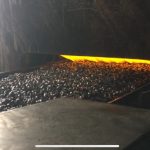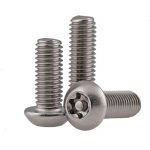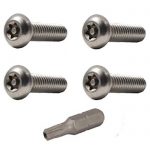Galvanized
Electro-galvanizing is the most commonly used coating for commercial fasteners. It is cheaper and looks good, and it can be black or army green. However, its anti-corrosion performance is general, and its anti-corrosion performance is the lowest among zinc plating (coating) layers. Generally, the neutral salt spray test of electrogalvanization is within 72 hours, and special sealants are used to make the neutral salt spray test more than 200 hours, but the price is expensive, which is 5-8 times that of general galvanizing.
Electro-galvanizing is prone to hydrogen embrittlement, so bolts above 10.9 are generally not galvanized. Although the oven can be used to remove hydrogen after plating, the passivation film will be destroyed when the temperature is above 60℃, so hydrogen removal is necessary Performed after plating before passivation. Such operability is poor and the processing cost is high. In reality, the general production plant will not take the initiative to remove hydrogen, unless mandatory requirements of specific customers.
Electro-galvanized fasteners have poor torque-pre-tightening force consistency and are unstable, and are generally not used for connection of important parts. In order to improve the torque-pre-tightening force consistency, the method of coating lubricating substances after plating can also be used to improve and increase the torque-pre-tightening force consistency.
Phosphating
A basic principle is that phosphating is cheaper than galvanizing and has worse corrosion resistance than galvanizing. Oil should be applied after phosphating. The level of corrosion resistance has a great relationship with the performance of the applied oil. For example, applying general anti-rust oil after phosphating, the neutral salt spray test only lasts 10-20 hours. Apply high-grade anti-rust oil for 72~96 hours. But its price is 2 to 3 times that of general phosphating oil.
There are two commonly used fastener phosphating, zinc phosphating and manganese phosphating. Zinc-based phosphating has better lubrication performance than manganese-based phosphating, and manganese-based phosphating has better corrosion resistance and wear resistance than galvanized. Its operating temperature can reach 225°F to 400°F (107~204°C).
Especially the connection of some important parts. For example, connecting rod bolts and nuts of the engine, cylinder heads, main bearings, flywheel bolts, wheel bolts and nuts, etc.
High-strength bolts are phosphated, which can also avoid hydrogen embrittlement, so bolts above 10.9 in the industrial field generally use phosphating surface treatment.
Oxidation (blackening)
Blackening + oiling is a popular coating for industrial fasteners because it is the cheapest and looks good before the oil runs out. Since it has almost no anti-rust ability due to blackening, it will rust soon after it has no oil. Even in the presence of oil, the neutral salt spray test can only reach 3 to 5 hours.
Cadmium plating
The corrosion resistance of cadmium coating is very good, especially in the marine atmosphere, the corrosion resistance is better than other surface treatments. The waste liquid treatment in the process of cadmium electroplating is expensive and costly, and its price is about 15-20 times that of electrogalvanized. Therefore, it is not used in general industries and only used in some specific environments. For example, fasteners for oil drilling platforms and HNA aircraft.
Chrome plating
The chromium plating layer is stable in the atmosphere, is not easy to change color and lose its luster, has high hardness and good wear resistance. Chrome plating on fasteners is generally used for decoration. It is rarely used in industrial fields with high anti-corrosion requirements, because good chrome-plated fasteners are as expensive as stainless steel. Only when the strength of stainless steel is not enough, chrome-plated fasteners are used instead.
In order to prevent corrosion, copper and nickel should be plated before chrome plating. The chromium coating can withstand high temperatures of 1200°F (650°C). But it also has the same hydrogen embrittlement problem as electro-galvanized.
Nickel plated
Mainly used in places where both anti-corrosion and good conductivity are required. Such as the lead-out terminal of the vehicle battery.
Hot dip galvanized
Hot-dip zinc is a thermal diffusion coating of zinc heated to liquid. The thickness of the coating is 15-100μm, and it is not easy to control, but it has good corrosion resistance and is mostly used in engineering. During the hot-dip galvanizing process, pollution is serious, including zinc waste and zinc vapor.
Due to the thick plating, the problem that the internal and external threads are difficult to screw together is caused in the fastener.
Due to the temperature of hot-dip galvanizing (340-500C), it cannot be used for fasteners above 10.9.
Sherardizing
Sherardizing is zinc powder solid metallurgical thermal diffusion coating. Its uniformity is good, and uniform layers can be obtained in threads and blind holes. The thickness of the coating is 10~110μm, and the error can be controlled within 10%. Its bonding strength and anti-corrosion performance with the substrate is the best among zinc coatings (electro-galvanized, hot-dip galvanized, dacromet). The processing process is pollution-free and the most environmentally friendly.
Dacromet
There is no hydrogen embrittlement problem, and the torque-pre-tightening force is consistent. If the environmental issues of hexavalent chromium are not considered, it is actually the most suitable for high-strength fasteners with high anti-corrosion requirements.











